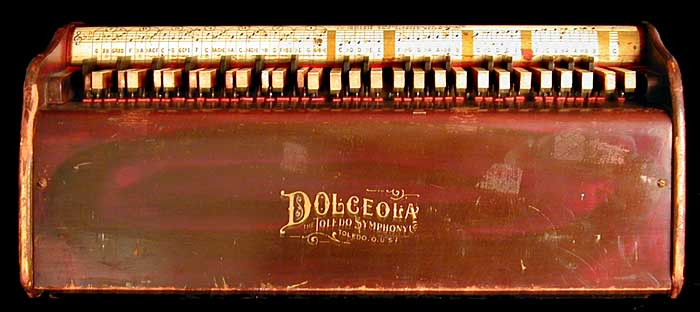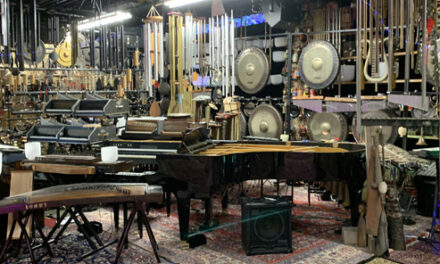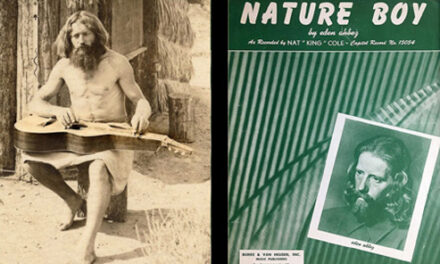Here’s an impromptu non-harp guitar-related post that I thought would be a treat for those into any and all of the following seemingly unrelated topics:
- Lead Belly
- ‘50s folk-pop music
- Edgar Bergen
- Therapy Dogs
- Hollywood
- The Dolceola
Yes, believe it or not, they converge thusly:

Within my extensive Dolceola section in the Fretless Zithers portion of my Miner Music web site, I have a short page on 12-string guitar legend Lead Belly, who included the instrument on some recordings. The musician was session player Paul Howard, and this charming guest blog was written by his daughter, Laurel (via an “Internet letter” to me – her first, she says!). Thanks to Laurel for allowing me to share and for the wonderful new photograph!
“I recently discovered your information about Dolceolas. I have an intimate connection with one of these tiny piano-like instruments that belonged to my father, musician/songwriter Paul Mason Howard, from some point in the 1930s until his death in 1975. He would have been living in Michigan and also working in Big Bands in Chicago when he found it. It was quite primitive and definitely looked “homemade.” He played it on Capitol Recordings with Lead Belly in 1944 and later recorded with Tennessee Ernie Ford and other pop artists who liked to sing material with folk history.
“Huddie Ledbetter was a houseguest in our West Hollywood home when he visited California. I was a very small child then but in later years my mother recounted some anecdotes about Lead Belly, his dark past and his natural sweetness and gratefulness for the kind welcome given him by our family.
“In the 1944 recording of “Chickens Crow at Midnight,” he included me in a line that said « Little Lolly gets so happy cuz it’s Christmas Day…. ». I found a Capitol CD collection of his old recordings with this song on it and bought it for my son some years ago. “My dad played many instruments but mostly the piano. I have read that he collected odd instruments. but, in fact, there was only his beloved keyboard zither. I do not believe he even knew terms like “Dolceola” or “Cithare.” (GM: The three images of Howard with his Dolceola show the instrument from the audience’s perspective. “Dolceola” appeared as a decal on the player’s side, so it’s possible that this was worn off Howard’s specimen, preventing him from ever learning its origin!)

“He loved the sound it made. He even preferred writing on it to using the big piano. He often played it when he visited children’s hospital wards with his large black poodle who played along on a small drum with her fluffy tail. The children loved the funny dog but the zither with its tiny keys and tinkle-y sound really fascinated them (as it had always done for me).

“I was living in Europe at the time of his death and do not know what happened to Dad’s keyboard zither or to the 12-string guitar that was given to him by Lead Belly that always stood in a corner of his living room. “I have seen two old Capitol photos online of Paul Howard with Lead Belly. He is holding his keyboard zither on his lap. Internet comments imply from this that he played it on his lap. It was quite heavy and cumbersome and this is doubtful. (GM: I would agree. I located the Getty-watermarked images, which are shown here. Asking her about him appearing to pluck the strings like a typical fretless zither, she answered:) People just pose for photos without thinking much and Paul rarely did anything with the strings. For him, it was really just a keyboard instrument that he managed to play with unusual skill for a person who had very large hands. Those tiny keys were so close together and he could work them so fast!

“Though he loved the folk quality the sound gave to his lesser known songs with American historical roots than just his Disney work, “Shrimp Boats” and “The Gandy Dancer’s Ball,” he was really a traditional jazz piano player and it amused his friends when he played jazz on the little zither instead of moving to the piano. (GM: Howard didn’t actually write these tunes for Disney; he licensed them to the Company in the early 1950s when Disney’s music division was trying to get into the pop music business. Through this, they thus became official “Walt Disney Music Co.” songs.)
“He usually set it on a stool and played it standing or put it on a table and sat on a chair. I enclose a photo of him with Edgar Bergen and Charlie McCarthy at a broadcast of Bergen’s famous radio program in 1951. Dad was special guest, celebrating his current hit song “Shrimp Boats.” I attended the broadcast and he did sing and stand to play with the show’s orchestra in front of the live audience.
“Cordially yours, Laurel Howard”

So there you have it – some background on the world’s only known professional Dolceola player!
Well, actually, there was another known Dolceola player (and of course today we have Andy Cohen). I’m speaking of Clifford Herman Snyder, aka “Herman the Hermit,” who played the occasional Dolceola along with a hundred instruments (often at the same time) during his own Hollywood career that overlapped Paul Howard’s time in Hollywood. Surely they must have known each other?!

Since I wrote my Lead Belly piece, which included then-rare sound clips of the Capitol recordings with Paul Howard, the recordings have turned up on YouTube (as everything eventually seems to). So one can search on the titles and hear the songs now in their entirety. Fascinating stuff.

Curious about Paul Howard’s self-penned songs and other possible recordings, I found a few other fun things. The two “Disney songs” Laurel mentions above were co-written by Howard and Paul Weston. Weston’s wife was popular singer Jo Stafford, who had a huge hit in 1951 with the team’s “Shrimp Boat,” heard here. It sure sounds like she’s backed by a Dolceola, doesn’t it?! It’s an odd, but quite catchy and interesting tune – apparently Weston and Stafford “had a deep interest and love for New Orleans; this song presents a particular facet of life in that region.”
Meanwhile, “The Gandy Dancer’s Ball” is a wacky thing, performed here by Tennessee Ernie Ford. I can’t imagine Howard not playing on the recording, but I don’t hear the Dolceola.
Alas, it got a good run there for a while!







Hi Gregg, Today I discovered another recording that includes prominent Dolceola work, namely Tex Williams’ recording of Shrimp
Boats. One can only assume the player is Paul Mason. Just thought I’d pass this along.
R
I love the Shrimp Boat song. Very cool to hear the instrument.